
Woodhouse railway station serves Woodhouse and Woodhouse Mill in Sheffield, South Yorkshire, England. The station is 5.25 miles (8 km) east of Sheffield station on the Sheffield to Lincoln Line.

Mansfield Woodhouse railway station serves the settlement of Mansfield Woodhouse, which adjoins the town of Mansfield, both located in Nottinghamshire, England.
Rotherham Main Colliery was situated in Canklow, about 0.5 miles south of Rotherham town centre in the Rother Valley. The area was the site of an ancient crossing of the river set below the crag on which were Canklow Woods, an ancient woodland area.
Tinsley Park Collieries were a group of coal mines situated in the Tinsley / Darnall area to the east of the City of Sheffield, South Yorkshire, England.
Kilnhurst Colliery, formerly known as either Thrybergh or Thrybergh Hall Colliery, was situated on the southern side of the village of Kilnhurst, near Rotherham, South Yorkshire, England.
The Lancashire, Derbyshire and East Coast Railway (LD&ECR) was built to connect coalfields in Derbyshire and Nottinghamshire with Warrington and a new port on the Lincolnshire coast. It was a huge undertaking, and the company was unable to raise the money to build its line. With the financial help of the Great Eastern Railway it managed to open between Chesterfield and Lincoln with a branch towards Sheffield from 1896. Despite efforts to promote tourist travel, the passenger business was never buoyant, but collieries were connected to the line, at first and in succeeding years. The Great Eastern Railway, and other main line companies, transported coal to the southern counties, and the company's engines took coal to Immingham in great quantities. The company had a fleet of tank engines.
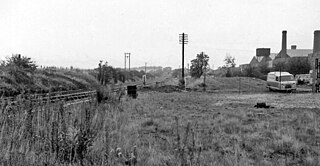
Boughton railway station served the village of Boughton in Nottinghamshire, England from 1897 to 1955 when it was closed. It has since been razed to the ground.
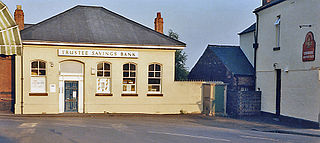
Clowne South railway station is a former railway station in Clowne, Derbyshire, England.

Spinkhill railway station is a disused railway station in Spinkhill, Derbyshire, England.
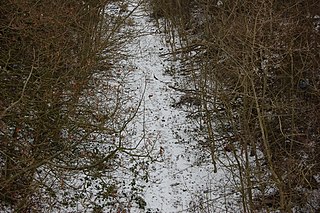
Upperthorpe and Killamarsh was a railway station that served the villages of Killamarsh and Upperthorpe in Derbyshire, England. It was one of three stations serving Killamarsh. The station was on the Sheffield District Railway which ran between Sheffield Victoria and Shirebrook North on the Lancashire, Derbyshire and East Coast Railways network of lines in the region.
Clipstone Colliery Sidings railway station was a station in Clipstone, Nottinghamshire.
Elsecar goods station was a goods facility constructed near the village of Elsecar, near Barnsley, South Yorkshire, at the terminus of the South Yorkshire Railways branch line from Elsecar Junction on its Mexborough to Barnsley line. The total length of the line was 2 miles 1204 yards.
Moss Valley branch was a two mile long single track line built by the Great Western Railway in what is now the county borough of Wrexham, Wales. It ran from a junction with the Wrexham and Minera Railway at Moss Valley Junction to Moss Halt via three intermediate stations: Gatewen Halt, Pentre Broughton Halt, and Gwersyllt Hill Halt.

Duckmanton Junction is a former railway junction near Arkwright Town in Derbyshire, England.
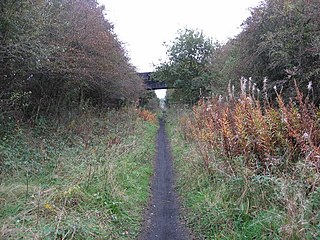
Pleasley East is a former railway station in Pleasley, Derbyshire, England on the Nottinghamshire border near Mansfield.
The Clowne Branch is a disused railway line in north eastern Derbyshire, England. Which runs from Creswell to Staveley. Historically it ran to Chesterfield. It is now in use as a greenway.
The Doe Lea branch is a mothballed railway line in Derbyshire, England. It connected the Derbyshire towns of Chesterfield, Staveley and Bolsover to the Nottinghamshire town of Mansfield. It also had a branch line to Creswell via the Derbyshire town of Clowne.
The Hull and Doncaster Branch is a secondary main railway line in England, connecting Kingston upon Hull to South Yorkshire and beyond via a branch from the Selby Line near Gilberdyke to a connection to the Doncaster–Barnetby line at a junction near Thorne 8 miles north-east of Doncaster.
The Leen Valley lines of the Great Northern Railway were railway branch lines built to access the collieries in the Nottinghamshire coalfield in England. The Midland Railway had long been dominant in the area, but there was resentment against its monopolistic policies from coalowners, who encouraged the Great Northern Railway to build a line. The Leen Valley Line was opened in 1881; it ran as far as Annesley colliery. A passenger service was run the following year, and very considerable volumes of coal were hauled.
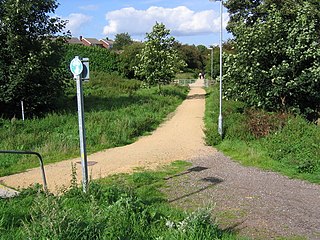
Skeby railway station served the village of Skegby, Nottinghamshire in England.









